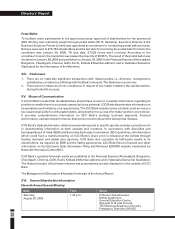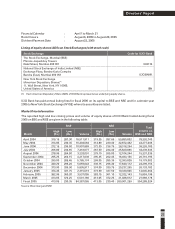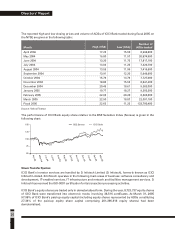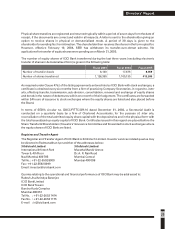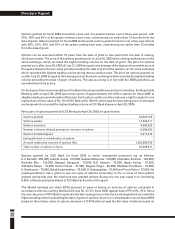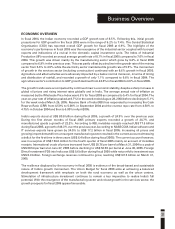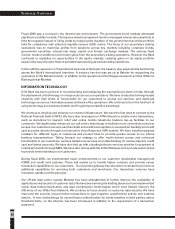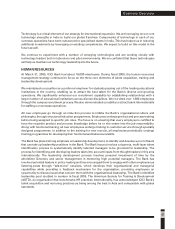ICICI Bank 2005 Annual Report Download - page 33
Download and view the complete annual report
Please find page 33 of the 2005 ICICI Bank annual report below. You can navigate through the pages in the report by either clicking on the pages listed below, or by using the keyword search tool below to find specific information within the annual report.
31
ECONOMIC OVERVIEW
In fiscal 2004, the Indian economy recorded a GDP growth rate of 8.5%. Following this, initial growth
projections for GDP growth in the fiscal 2005 were in the range of 6.2% to 7.4%. The Central Statistical
Organisation (CSO) has reported overall GDP growth for fiscal 2005 at 6.9%. The highlight of the
economy’s performance in fiscal 2005 was the resurgence of the industrial sector coupled with buoyant
exports and indications of a revival in the domestic capital investment cycle. The Index of Industrial
Production (IIP) recorded an annual average growth rate of 8.1% in fiscal 2005 compared to 7.0% in fiscal
2004. This growth was driven mainly by the manufacturing sector which grew by 9.2% in fiscal 2005
compared to 6.9% in the previous year. This was partly offset by a decline in the growth rate of the mining
sector from 6.6% to 4.5% while the electricity sector maintained its growth rate of 5.5%. The momentum
of growth in the services sector (including construction) continued with an 8.6% growth in fiscal 2005.
Agriculture and allied activities were adversely impacted by a below normal monsoon, in terms of timing
and distribution of rainfall, and recorded a growth of only 1.1% compared to 9.6% in fiscal 2004. The
agriculture sector's contribution to GDP growth declined from 24.0% in fiscal 2004 to 3.6% in fiscal 2005.
The growth trends were accompanied by continued macro-economic stability, despite a sharp increase in
global oil prices and rising interest rates globally and in India. The average annual rate of inflation as
measured by the Wholesale Price Index was 6.5% for fiscal 2005 as compared to 5.4% for fiscal 2004. The
year-on-year rate of inflation peaked at 8.7% for the week ended August 28, 2004 before declining to 5.1%
for the week ended March 26, 2005. Reserve Bank of India (RBI) has responded by increasing the Cash
Reserve Ratio (CRR) from 4.50% to 5.00% in September 2004 and the reverse repo rate from 4.50% to
4.75% in October 2004 and then to 5.00% in April 2005.
India’s exports stood at US$ 80.8 billion during fiscal 2005, a growth of 24.9% over the previous year.
During the first eleven months of fiscal 2005 primary exports recorded a growth of 24.7% and
manufactured goods a growth of 22.2%. According to RBI, invisibles receipts reached US$ 77.5 billion
during fiscal 2005, a growth of 46.3% over the previous year. According to NASSCOM, Indian software and
IT services exports have grown by 34.5% to US$ 17.2 billion in fiscal 2005. Increasing oil prices and
growing import demand from a resurgent manufacturing sector resulted in the current account witnessing
a deficit for the first time in three years (US$ 6.4 billion during fiscal 2005). The current account however,
was in a surplus of US$ 159.0 million for the fourth quarter of fiscal 2005 mainly on account of invisibles
receipts. International crude oil prices increased from US$ 35.76 per barrel at March 31, 2004 to a peak of
US$ 60.54 per barrel at June 27, 2005 before declining to US$ 56.50 per barrel at June 30, 2005. Foreign
Direct Investment (FDI) into India was US$ 5.6 billion during fiscal 2005 while net portfolio investment was
US$ 8.9 billion. Foreign exchange reserves continued to grow, reaching US$141.5 billion on March 31,
2005.
The resilience displayed by the economy in fiscal 2005 is evidence of the broad-based and sustainable
nature of India’s growth momentum. The Union Budget for fiscal 2006 aims at achieving a balanced
development framework with emphasis on both the rural economy as well as the urban centres.
Stimulation of infrastructure investment continues to remain a key imperative to realise India’s full
potential. With the resurgence of the manufacturing sector and robust growth in the services sector, the
growth prospects for fiscal 2006 appear favourable.
Business Overview
Dickenson Tel: 022-2625 2282



